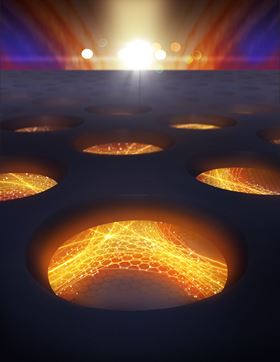 An artist’s illustration of the array of nanoscale holes in graphene. Image: Carl Otto Moesgaard.
An artist’s illustration of the array of nanoscale holes in graphene. Image: Carl Otto Moesgaard.For almost 15 years, scientists have tried to exploit the ‘miracle material’ graphene to produce nanoscale electronics. On paper, graphene should be perfect for that: it is ultra-thin – only one atom thick – and an excellent conductor of electrical current, making it ideal for future forms of electronics that are faster and more energy efficient. In addition, graphene consists of carbon atoms – of which there are an unlimited supply.
In theory, graphene can be modified to perform many different tasks within electronics, photonics or sensing by simply by drawing tiny patterns on it, which fundamentally alter its quantum properties. One ‘simple’ task that has actually turned out to be surprisingly difficult is to induce a bandgap, which is crucial for making transistors and optoelectronic devices. Because graphene is only an atom thick, even tiny irregularities in the pattern can destroy its properties.
"Graphene is a fantastic material, which I think will play a crucial role in making new nanoscale electronics. The problem is that it is extremely difficult to engineer the electrical properties," says Peter Bøggild, a professor of physics at the Technical University of Denmark (DTU).
The Center for Nanostructured Graphene, jointly based at DTU and Aalborg University in Finland, was established in 2012 specifically to study how the properties of graphene can be engineered, by, for example, making a very fine pattern of holes. These holes should subtly change the quantum nature of the electrons in the material and allow the properties of graphene to be tailored. However, the team of researchers from DTU and Aalborg University discovered the same as many other researchers worldwide: it didn't work.
"When you make patterns in a material like graphene, you do so in order to change its properties in a controlled way – to match your design. However, what we have seen throughout the years is that we can make the holes, but not without introducing so much disorder and contamination that it no longer behaves like graphene. It is a bit similar to making a water pipe with a poor flow rate because of coarse manufacturing. On the outside, it might look fine. For electronics, that is obviously disastrous," says Bøggild.
Now, as they report in a paper in Nature Nanotechnology, the researchers have solved the problem. Two postdocs from DTU, Bjarke Jessen and Lene Gammelgaard, encapsulated graphene inside another two-dimensional (2D) material – hexagonal boron nitride, a non-conductive material that is often used to protect graphene's properties.
Next, they used a technique called electron beam lithography to carefully pattern both the protective layer of boron nitride and the graphene below with a dense array of ultra-small holes. The holes have a diameter of approximately 20nm and are separated by just 12nm, while the roughness at the edge of the holes is less than 1nm. This array of holes allows 1000 times more electrical current to flow than had previously been reported in such small graphene structures.
"We have shown that we can control graphene's band structure and design how it should behave. When we control the band structure, we have access to all of graphene's properties – and we found to our surprise that some of the most subtle quantum electronic effects survive the dense patterning – that is extremely encouraging. Our work suggests that we can sit in front of the computer and design components and devices – or dream up something entirely new - and then go to the laboratory and realise them in practice," says Bøggild.
"Many scientists had long since abandoned attempting nanolithography in graphene on this scale, and it is quite a pity since nanostructuring is a crucial tool for exploiting the most exciting features of graphene electronics and photonics. Now we have figured out how it can be done; one could say that the curse is lifted. There are other challenges, but the fact that we can tailor electronic properties of graphene is a big step towards creating new electronics with extremely small dimensions."
This story is adapted from material from the Technical University of Denmark, with editorial changes made by Materials Today. The views expressed in this article do not necessarily represent those of Elsevier. Link to original source.